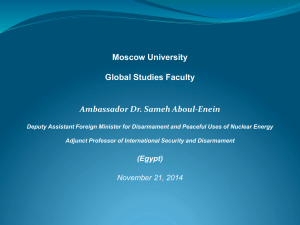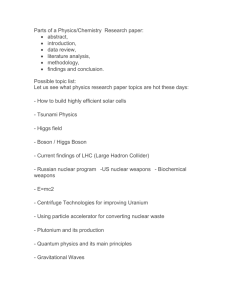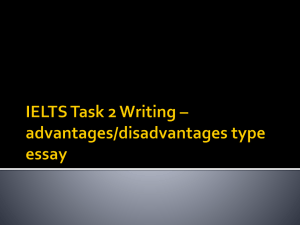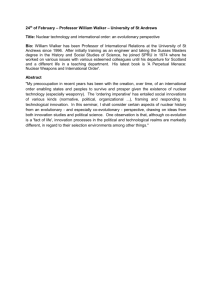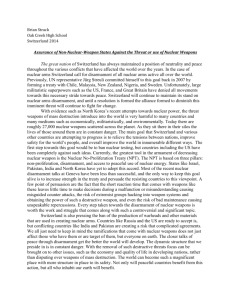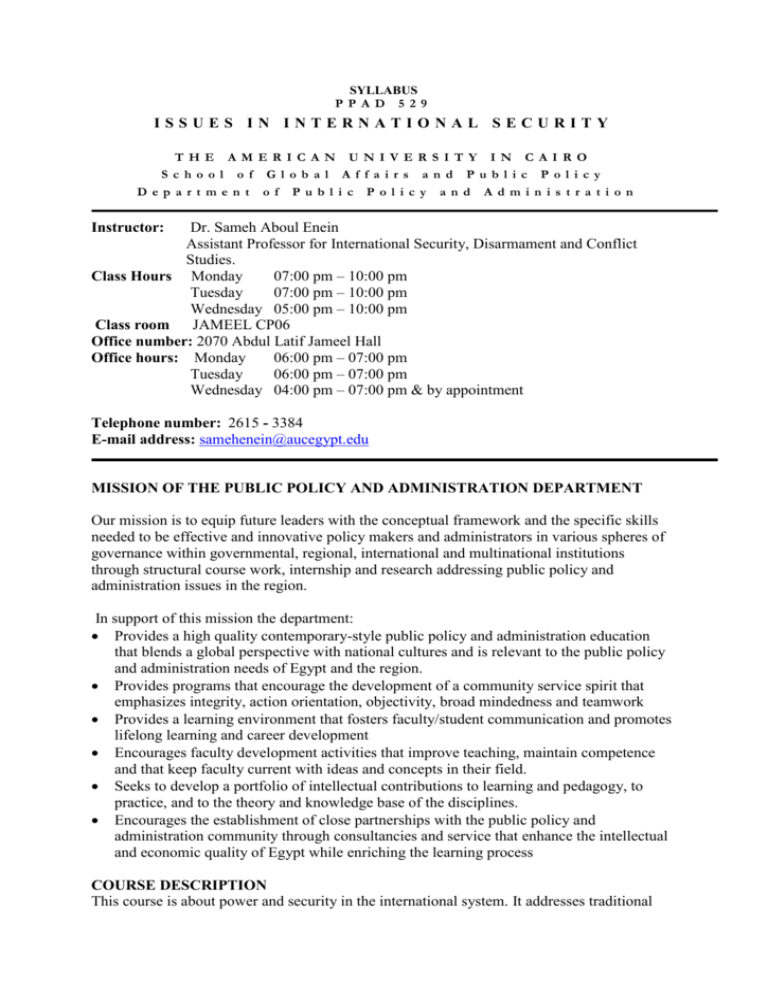
SYLLABUS
PP A D 5 29
ISSUES IN INTERNATIONAL SECURITY
THE AM ER IC A N UN IV ER S I T Y IN C AI RO
Sc ho ol o f G l ob a l A f fa ir s an d Publ ic P ol ic y
Dep a r t men t of Publ i c P ol ic y and A dm in is tr a ti on
Instructor:
Dr. Sameh Aboul Enein
Assistant Professor for International Security, Disarmament and Conflict
Studies.
Class Hours Monday
07:00 pm – 10:00 pm
Tuesday
07:00 pm – 10:00 pm
Wednesday 05:00 pm – 10:00 pm
Class room JAMEEL CP06
Office number: 2070 Abdul Latif Jameel Hall
Office hours: Monday
06:00 pm – 07:00 pm
Tuesday
06:00 pm – 07:00 pm
Wednesday 04:00 pm – 07:00 pm & by appointment
Telephone number: 2615 - 3384
E-mail address: samehenein@aucegypt.edu
MISSION OF THE PUBLIC POLICY AND ADMINISTRATION DEPARTMENT
Our mission is to equip future leaders with the conceptual framework and the specific skills
needed to be effective and innovative policy makers and administrators in various spheres of
governance within governmental, regional, international and multinational institutions
through structural course work, internship and research addressing public policy and
administration issues in the region.
In support of this mission the department:
Provides a high quality contemporary-style public policy and administration education
that blends a global perspective with national cultures and is relevant to the public policy
and administration needs of Egypt and the region.
Provides programs that encourage the development of a community service spirit that
emphasizes integrity, action orientation, objectivity, broad mindedness and teamwork
Provides a learning environment that fosters faculty/student communication and promotes
lifelong learning and career development
Encourages faculty development activities that improve teaching, maintain competence
and that keep faculty current with ideas and concepts in their field.
Seeks to develop a portfolio of intellectual contributions to learning and pedagogy, to
practice, and to the theory and knowledge base of the disciplines.
Encourages the establishment of close partnerships with the public policy and
administration community through consultancies and service that enhance the intellectual
and economic quality of Egypt while enriching the learning process
COURSE DESCRIPTION
This course is about power and security in the international system. It addresses traditional
and new threats to international security. Inter-State territorial and intra-State ethnic conflicts
are examples of the former. Conflicts, actual or potential, deriving from the wide use of
extremist violence by transnational groups or over the use of non-renewable natural resources
and the population displacement consequences of climate change are instances of such
conflicts. The course will also address the search for peace and security and the need for
global governance of security. National policies, particularly those of great and medium-size
powers, with regard to security threats and mechanisms of governance will be perused.
INTENDED LEARNING OUTCOMES
After completing the course successfully, the students will be able to:
-
Display an understanding of traditional and new threats to international security;
Analyze the roles, opportunities and limitations of traditional and new actors in
international security;
Analyze national and international/regional organizations’ policies to deal with
specific security threats;
Understand the different stages of a conflict and the alternative approaches used to
address each one;
Apply an understanding of negotiation and other techniques to resolve conflicts at
each stage of the conflict prevention-resolution-recovery process.
MAIN TOPICS TO BE COVERED
READINGS
I. Required Readings
Andrew, Christopher. The Defence of the Realm: The Authorized History of Mi5 (London,
2009)
Acharya, Amitav and Arabinda Acharya (2007), “The Myth of the Second Front: Localizing
the War on Terror in Soutjeast Asia”, Washington Quarterly, Autumn, pp. 75-90
[online]
Art, Robert J., “The Fungibility of Force”, in Robert Art and Kenneth Waltz, eds., The Use
of Force: Military Power and International Politics.
Bercovitch, J. (1992). Mediators and mediation strategies in international relations.
Negotiation Journal, 8, 99-112
Barry Rubin (2002). The Tragedy of the Middle East. New York: Cambridge University
Press.
Bar-Siman-Tov, Yaacov (2007). Israeli- Palestinian conflict: from conflict resolution to
conflict management. Palgrave Macmillan, Gordonsville, VA, USA (ebook)
Goertz, Gary and Patrick Regan (1997), “Conflict Management in Enduring Rivalries”,
International Interactions, no. 22, pp. 321-340.IISS Towards a regional security regime
for the Middle East.
Jim Bryant (2011). Conflict evolution tracking the Middle East Conflict. Group Decision
and Negotiation.
C. Raja Mohan, “India and the Balance of Power,” Foreign Affairs (May/June 2006).
Caldwell, Dan, Seeking Security in an Insecure World. Chapter 1, pp. 1-15.
Catriona Gourlay Executive Director (2004): European Union procedures and resources for
crisis management, International Peacekeeping, 11:3,404-421
2
Clapham, Christopher, “The Global-Local Politics of State Decay”, in Robert Rotberg, ed.,
When States Fail: Causes and Consequences. pp. 77-93
Cockayne, James and Christoph Mikulaschek (2008), Transnational Security Challenges and
the UN: Overcoming Sovereign Walls and Institutional Silos, International Peace
Academy, pp. 1-14 [online]
Cockayne, James (2007), Transnational Organized Crime: Multilateral Responses to a
Rising Threat. International Peace Research Institute Policy Paper, April, pp. 1-20
CNS, NPT Briefing Book, Part II, Section Q, “Documents on the Middle East,”
http://cns.miis.edu/research/npt/briefingbook_2008/pdfs/sectionQ.pdf
David Hafemeister, “The Comprehensive Test Ban Treaty: Effectively Verifiable,” Arms
Control Today (October 2008)
Dupont, Alan (2008), “The Strategic Implications of Climate Change”, Survival, June/July,
pp. 29-47
Egstrom, O. (1990). Norms, culture, and cognitive patterns in foreign aid negotiations.
Negotiation Journal, 6, 147-159
Fan He, Donghai Qin (2006), “China’s Energy Strategy in the Twenty-first Century”, China
and World Economy, Volume 14, no. 2, pp. 93-105 [online]
Fukuyama, Francis and Michael McFaul (2008), “Should Democracy Be Promoted or
Demoted?” Washington Quarterly, Winter, pp. 23-45 [onlie]
Gerald M. Steinberg, "Examining Israel's NPT Exceptionalism: 1998-2005," The
Nonproliferation Review. (March 2006).
George Bunn, "The Nuclear Nonproliferation Regime and its History," chapter 3 in George
Bunn and Christopher F. Chyba, editors, U.S. Nuclear Weapons Policy. (Brookings,
2006).
George Bunn and Christopher F. Chyba, "U.S. Nuclear Weapons Policies for a New Era,"
chapter 8 in George Bunn and Christopher F. Chyba, editors, U.S. Nuclear Weapons
Policy. (Brookings 2006).
George P. Shultz, William J. Perry, Henry Kissinger, and Sam Nunn. “A World Without
Nuclear Weapons,” Wall Street Journal (January 4, 2007 and January 15, 2008).
George Perkovich, James M. Acton, Lawrence Freedman, Frank Miller, Jonathan Schell,
Brad Roberts, Harald Müller, Bruno Tertrais, Achilles Zaluar, Scott Sagan, Takaya
Suto, Hirofumi Tosaki, James Doyle, Patricia Lewis, Ian Hore-Lacy, Pan Zhenqiang,
V.R. Raghavan, Sameh Aboul-Enein, Ernesto Zedillo, Zia Mian (2009) Carnegie
Endowment for International Peace. All rights reserved. Abolishing Nuclear Weapons:
A debate
Goldstein, Joshua S. and Jon C. Pevehouse (2009), “Environment and Population”, in
International Relations, 8th edition. New York, Pearson Longman
3
Ikenberry, G. John (2008), “The Rise of China and the Future of the West”, Foreign Affairs,
September-October, pp. 23-37 [online]
Isenberg, David, “A Government in Search of Cover: Private Military Companies in Iraq”,
in Chesterman and Lehnardt, from Mercenaries to Market, pp. 82-93 [online]
Ivo Daalder and Jan Lodal, "The Logic of Zero: Toward a World Without Nuclear
Weapons," Foreign Affairs. (November/Decembr 2008).
James, Clay Moltz (2003), New Challenges in missile proliferation, missile defense and
space security. Monterey Institute of International Studies. Occasional paper no.12.
Jean du Preez, “The Fissban: Time for a Renewed Commitment or a New Approach?
”Disarmament Diplomacy 79 (April/May 2005).
John Simpson, “The 2000 NPT Review Conference,” SIPRI Yearbook 2001, Appendix 6B,
pp. 1-16.
Jones, R. V., 1978, Most Secret War: British Scientific Intelligence 1939-1945, London:
Hamish Hamilton.
Kathleen Bailey, "Why Do We Have to Keep the Bomb?" Bulleting of Atomic Scientists.
(January/February 1995).
Kaufmann, Chaim (2005), “Rational Chocie and Progress in the Study of Ethnic Conflict”,
Security Studies, January-March, pp. 178-207 [online]
Keohane, Robert O. and Joseph Nye, “Power and Interdependence”, in Betts, Conflict After
the Cold War. Pp. 121-127
Konstantinos D. Magliveras and Gino J. Naldi (2002). The African Union: A New Dawn for
Africa? The International and Comparative Law Quarterly, Vol. 51, No. 2, pp. 415-425
Leander, Anna (2005), “The Marker for Force and Public Security: The Destabilizing
Consequences of Private Military Companies”, Journal of Peace Research, pp. 605-622
Marco Pinfari (2009), Nothing but failure the Arab League and the Gulf Cooperation
Council as Mediators in Middle Eastern Conflicts. London school of Economics Crisis
States Working Papers Series No.2.
Matthews, Jessica (1997), “Power Shift”, Foreign Affairs, January-February, pp. 50-66
[online]
Moran, T.H. (1990/91), “International Economics as a National Security Issue”, in Security
Studies Today, pp. 115-134
Money, B. (1998). International multilateral negotiation and social networks. Journal of
International Business Studies, 29(4).
Oliver Meier, “The European Union’s Nonproliferation Strategy: An Interview with
Annalisa Gianella,” Arms Control Today, July 24, 2005,
http://www.armscontrol.org/interviews/20050724_Giannella.asp.
Patrick, Stewart (2006), “Weak States and Global Threats: Fact or Fiction?”, Washington
Quarterly, pp. 29-53 [online]
Peppi DeBiaso (2006). Proliferation, Missile Defense and the Conduct of Modern
War, Comparative Strategy, 25:3, 157-171
Potter, William C. and Gaukhar Mukhatzhanova (2008), “Divining Nuclear Intentions: A
Review Essay”, International Security, Summer, pp. 139-169 [online]
Perkovich, George (2006), “The End of the Non-proliferation Regime?”, Current History,
November, pp. 355-362 [online]
4
Raymond Cohen, Negotiating across cultures. United States Institute of Peace 1998.
Rosenau, James N. (1995), “Governance in the Twenty-first Century”, Global Governance,
no. 1, pp. 13-43
R. Fisher and D. Shapiro, Beyond Reason (Penguin Books, 2005).United Nations, A More
Secure World: Our Shared Responsibility. Pp. 1-19 [online]
Richard L. Russell. Off and running: the Middle East nuclear arms race. JFQ / issue 58, 3d
quarter 2010
Sameh Aboul-Enein," International relations, national interests & foreign policy making in
the ME". PH.D dissertation, university of London.
Sameh Aboul-Enein 2009, “Challenges for the Non-Proliferation Regime and the Middle
East” Disarmament Diplomacy, Issue no. 90. Spring 2009.
Sameh Aboul-Enein and Bharath Gopalaswamy (2009). Missile Regime, Verification, Test
Bans and Free Zones, Disarmament Forum No. 4, UNIDIR, Geneva.
Sameh Aboul-Enein, “NPT 2010: The Beginning of a New Constructive Cycle”, Arms
Control Today, November 2010.
Senese, Paul and Stephen Quackenbush (2003), “Sowing the Seeds of Conflict: the Effect of
Dispute Settlements on Durations of Peace, The Journal of Politics, Volume 65, no. 3,
pp. 696-717.
Sageman, Marc (2004), “Understanding Terror Networks”, Foreign Policy Research
Institute, November 1 [online]
Sharon Squassoni, "Closing Pandora's Box: Pakistan's Role in Nuclear
Proliferation," Arms Control Today (April 2004).
Shelley, Louise I. (1995), “Transnational Organized Crime: An Imminent Threat to the
Nation-State”, Journal of International Affairs 48, no. 2, Winter, pp. 463-489.
Short, Nicola (1999), “The Role of NGOs in the Ottawa Process to Ban Landmines”,
International Negotiation, pp. 481-500 [online]
Siegfried S. Hecker and William Lou, “Dangerous Dealings: North Korea’s Nuclear
Capabilities and the Threat of Export to Iran,” Arms Control Today (March 2007).
Singer, P.W. (2001/02), “Corporate Warriors: The Rise of the Privatized Military Industry
and Its ramifications for International Security”, International Security, Winter, pp. 186220
Stedman, Stephen John (2007), “UN Transformation in an Era of Soft Balancing”,
International Affairs, September, pp. 933-944 [online]
Steinbruner, John and Jason Forrester (2004), “Perspectives on Civil Violence: A Review of
Current Thinking”, in William Lahnemann, ed., Military Intervention. New York,
Rowman and Littlefield, pp. 1-27
Snyder, S. (2000). Negotiating on the edge: Patterns in North Korea's diplomatic style.
World Affairs, 163(1), 3-17.
Tariq Rauf and Rebecca Johnson, “After the NPT’s Indefinite Extension: The Future of the
Global Nonproliferation Regime,” Nonproliferation Review (Fall 1995), pp. 28-42 at
http://cns.miis.edu/pubs/npr/vol03/31/raufjo31.pdf.
Toffolo (2007); Rubin, 2002, pp. 227-257; Andersen et al. (2004), pp. 235-278.
Waltz, Kenneth, “The Origins of War in Neorealist Theory”, in Rotberg and Rabb, The
Origins and Prevention of Major wars. Pp. 39-52
Williams, Phil, “Transnational Criminal Organizations and International Security”, in World
Security Challenges for a New Century, edited by M. Klare and Y. Chandrani.
William Ury, Getting Past No: Negotiating Your Way from Confrontation to Cooperation.
5
William C. Potter (2005), “The NPT Review Conference: 188 States in Search of
Consensus,” The International Spectator, Vol. 3. (An assessment of the 2005 NPT Rev
Con).
Wright, Peter, & Greengrass, Paul. 1988 Spycatcher : The candid autobiography of a senior
intelligence officer / Peter Wright with Paul Greengrass.
II. Recommended Readings
Darryl Howlett and John Simpson, eds., Nuclear Non-Proliferation: A Reference Handbook
(1992), pp. 15-28, 51-56.
George Bunn, Arms Control by Committee: Managing Negotiations with the Russians (1992),
pp. 59-83.
Landau, Arms Control in the Middle East: Cooperative Security Dialogue and Regional
Constraints.
Merav Datan, “Nuclear futures for the Middle East: Impact on the goal of a WMD-free zone,”
Disarmament Forum 2008, No. 2, pp. 21-32, http://www.unidir.org/pdf/articles/pdfart2728.pdf
Paul Rivlin, “The Russian Economy and Arms Exports to the Middle East,” Jaffee Center,
November 2005, http://www.tau.ac.il/jcss/memoranda/memo79.pdf.
Raiffa, H. (1982). The Art & Science of Negotiation. Cambridge, MA: Harvard University
Press, Ch. 18, "The Law of the Sea," pp. 275-287.
R. Fisher and W. Ury, Getting to Yes: Negotiating Agreement without Giving In (Penguin
Books, 1981).
R. Fisher and S. Brown, Getting Together: Building Relationships as We Negotiate (Penguin
Books, 1988)
Richard Russell, “China’s WMD Foot In the Greater Middle East’s Door,” MERIA,
September 2005, http://meria.idc.ac.il/journal/2005/issue3/Russell%20pdf.pdf
Robert J. Einhorn et al., “The P-5 And Nuclear Nonproliferation,” CSIS Working Group
Report, December 2007, http://www.csis.org/media/csis/pubs/071210-einhorn-the_p5-web.pdf
Roy Lewicki, David Saunders, Bruce Barry, John Minton, Essentials of Negotiation
(4thedition, Irwin, 2007).
Roy Lewicki, David Saunders, Bruce Barry, John Minton, Negotiation Readings, Exercises &
Cases (5thedition, Irwin, 2006).
Sameh Aboul-Enein, The Road Map to Total Nuclear Disarmament, in Aboloshing Nuclear
Weapons: A Debate, Carnegie Endowment for International Peace, February 2009
Sameh Aboul-Enein, Challenges for the Nonproliferation Regime and the Middle East,
Disarmament Diplomacy, No. 90, Spring 2009
Sameh Aboul-Enein, NPT 2010: The Beginning of a New Constructive Cycle, Arms Control
Today, November 2010
Sameh Aboul-Enein and Hassan ELBahtimy, towards a verified nuclear weapon free zone in
the Middle East, VERTIC Brief, April 2010.
Sameh Aboul-Enein and Bharath Gopalaswamy. Missile Regime, Verification, Test Bans and
Free Zones, Disarmament Forum No. 4, 2009, UNIDIR, Geneva
Sammy Salama and Heidi Weber, “The Emerging Arab Response to Iran’s Unabated Nuclear
Program,” NTI Issue Brief, December 22, 2006, http://www.nti.org/e_research/e3_83.html
Shai Feldman 1997. Nuclear Weapons and Arms Control in the Middle East. Cambridge,
MA: MIT Press, pp. 121-150, 205-242.
6
Scott Sagan, “The Causes of Nuclear Weapons Proliferation,” Annual Review of Political
Science (2011), pp. 225-244.
Whitney Raas and Austin Long, “Osirak Redux? Israeli Capabilities to Destroy Iranian
Nuclear Facilities,” International Security 31:4 (Spring 2007) pp. 7-33.
William Epstein, The Last Chance: Nuclear Proliferation and Arms Control (1976).
William C. Potter, Nuclear Power and Nonproliferation: An Interdisciplinary Perspective
(1982).
William Ury, Getting Past No: Negotiating Your Way from Confrontation to Cooperation.
III.
Readings on Reserve
1
2
Author
IAEA Publications
Feldman, Shai, 1950
3
IISS
4
5
IISS
Johnson, Rebecca
6
The United Nations:
Disarmament Yearbook
The United Nations:
Disarmament Yearbook
Raiffa, Howard, 1924
Landau, Emily B.
7
8
9
10 Roy J. Lewicki, Bruce
Barry, David M. Saunders
11 Fisher, Roger 1922
12 Lewicki, Roy J.
13 United Nations
14 Sameh Aboul-Enein
15 Dr. Mohamed Shaker
16 Dr. Karem Mahmoud
Title
IAEA Annual Report 2010
Nuclear weapons and arms control in the Middle East/ by
Shai Feldman
Strategic survey 2011: The Annual Review of World
Affairs
Towards a regional security regime for the Middle East
Unfinished business: the negotiation of the CTBT and the
end of nuclear testing
Volume 35 (part I): 2010
Volume 35 (part II): 2010
The art and science of negotiation
Arms control in the Middle East: cooperative security
dialogue and regional constraints
Negotiation: readings, exercises and cases
Getting to Yes: negotiating agreement without giving in
Essentials of negotiation
NPT 2010 Document
"International relations, national interests & foreign policy
making in the ME". PH.D dissertation, university of
London.
Nuclear power in the Arab world & the regionalization of
the nuclear fuel cycle: an Egyptian Perspective
A nuclear-weapon-free zone in the Middle East : problems
and prospects
7
IV.
Additional Recommended Reading:
Jayantha Dhanapala with Randy Rydell, Multilateral Diplomacy and the NPT: An Insider’s
Account (2005).
R. Fisher and W.Ury (1981), Getting to Yes: Negotiating agreement without giving in.
Penguin book.
R. Fisher and S. Brown, Getting Together: Building Relationships as We Negotiate (Penguin
Books, 1988)
R. Fisher and W. Ury (Penguin Books, 1981), Getting to Yes: Negotiating Agreement without
Giving In.
R. Fisher and S. Brown (Penguin Books, 1988), Getting Together: Building Relationships as
We Negotiate
Raymond Cohen (1998), Negotiating across cultures. United States Institute of Peace.
Roy Lewicki, David Saunders, Bruce Barry, John Minton (2007), Essentials of Negotiations.
4th edition, Irwin.
Snyder, S. (2000). Negotiating on the edge: Patterns in North Korea's diplomatic style. World
Affairs, 163(1), 3-17.
William Ury, Jeanne Brett and Stephen Goldberg (1988), Getting disputes resolved: designing
systems to cut the cost of conflict. Jossey-Bass.
TEACHING METHODS
The teaching methods for this course will alternate between lecturing; presentation and class
discussions of assigned readings; and presentations by guest speakers and discussions.
Students will be asked successively to briefly and critically present and discuss the readings
assigned to them. Presenters will be identified at the end of each class for the following
session. The course consists of;
Lectures on International security, UN, security organizations, and regional
organizations.
Class discussions and student presentations on assigned International security, UN,
security organizations, and regional organization topics.
simulation games illustrating various aspects of International security and regional
organizations discussions of simulation outcomes in terms of formal decision making
models and negotiation theory.
COURSE GUIDELINES:
Students are kindly advised to:
- Regularly attend class sessions.
- Prepare beforehand for class sessions by reading text assignments and identifying
topics that needs clarification. Feel free to raise questions to ensure enough
understanding.
- Participate actively in class discussions and keep notes on your behavior, choices and
rationales as well as notes on your partners' and opponents' behavior.
- Periodically check course on blackboard.
- Communication skills complement analytical ones, so pay attention to completeness,
clarity, and aspect of written work. Grading is based on sound analysis, and on
effective communication of results.
- Hand in assignments on time. Late assignments will be devalued.
8
GRADING SYSTEM
The evaluation of students will be distributed as follows:
-
Attendance & Participation
Presentation
Skills exercises
Simulation
Geneva study
Final Exam
Total
10%
15%
5%
20%
30%
20%
100 %
ACADEMIC INTEGRITY
All students are expected to agree to and comply with the University Academic Integrity Policy which
states
“Valuing the concepts of academic integrity and independent effort, the American
University in Cairo expects from its students the highest standards of scholarly
conduct. The University community asserts that the reputation of the institution
depends on the integrity of both faculty and students in their academic pursuits and
that it are their joint responsibility to promote an atmosphere conducive to such
standards.”
Detailed information about the University Academic Integrity Policy may be found in the
Catalog and on the University Web site.
SCHEDULE OF TOPICS AND ASSOCIATED READINGS1, OF EXAMS AND
RESEARCH ASSIGNMENTS
First Week –Cairo
Session number Topic
(1)
United Nations organizations,
July 2, 2012
agencies and main issues (M.E).
Monday
7:00-10:00 pm
Assignments
Readings
And exams
(see detailed
bibliography above
Group presentation I
Caldwell and
Williams, chapter 1,
pp. 1-15; Waltz;
Keohane and Nye;
Paris; United Nations
The topics that
are suggested
1) UN System.
2) Organizations & agencies.
3) Issues relevant to
Nuclear Disarmament
4) Weapons of Mass
Destruction &
related agencies.
5) Identify internal& external
motivations of States in
the Middle East to acquire
Nuclear, chemical,
Mearsheimer, chapter
3, pp. 55-82; Art, pp.
3-22; Ikenberry, pp.
23-37.
Caldwell and
Williams, chapter 9,
pp. 117-128; Patrick,
pp.29-53; Clapham,
pp. 77-93
Caldwell and
Williams, chapter 2,
1
Heady, Turner and Hulme, Collins, World Development Reports and Human Development Reports will be on
reserve at the Library. Photocopies of all other readings will also be on reserve at the Library.
9
and/or biological weapons .
6) Research
the components of Nuclear
Weapons- Free Zones for
analysis of the Middles
East situation.
7) Challenges to the nonproliferation regime in
the Middle East.
8) Role of IAEA
in Nuclear NonProliferation.
9) Iran's Nuclear program.
10) Israel's
Nuclear program.
11) International security
organizations & issues.
12) Intelligence, data
collection, and new
threats (terrorism).
13) Regional organization,
negotiation & conflict
prevention- resolution
recovery.
Assignment Description :-
pp. 19-33; Matthews,
pp. 50-66; Short, pp.
481-500
Singer, pp. 186-220;
Leander, pp. 605-522;
Isenberg, pp. 82-93
George Perkovich,
James M. Acton,
Lawrence Freedman,
Frank Miller, Jonathan
Schell, Brad Roberts,
Harald Müller, Bruno
Tertrais, Achilles
Zaluar, Scott Sagan,
Takaya Suto, Hirofumi
Tosaki, James Doyle,
Patricia Lewis, Ian
Hore-Lacy, Pan
Zhenqiang, V.R.
Raghavan, Sameh
Aboul-Enein, Ernesto
Zedillo, Zia Mian
(2009) Carnegie
Endowment for
International Peace.
Abolishing Nuclear
Weapons: A debate.
1) 10 pages+ 10 sources
2) Double spaced.
3) 10
slides presentations to be pre
sented in class.
4) Hard copies of the paper&
the presentation must be
submitted in class.
5) Soft copies will
be submitted though Turnitin
Students are expected
to hand in
the presentation in hard
copy in class as well as
to Turnitin .
James, Clay Moltz
(2003), New
Challenges in missile
proliferation, missile
defense and space
security. Monterey
Institute of
International Studies.
Occasional paper
no.12.
John Simpson, “The
2000 NPT Review
Conference,” SIPRI
Yearbook
2001,
Appendix 6B, pp. 116.
Peppi DeBiaso (2006).
Proliferation, Missile
Defense and the
Conduct of Modern
War, Comparative
Strategy, 25:3, 157171
Richard L. Russell.
Off and running: the
Middle East nuclear
arms race. JFQ / issue
10
58, 3d quarter 2010
Sameh Aboul-Enein
and Bharath
Gopalaswamy (2009).
Missile Regime,
Verification, Test Bans
and Free Zones,
Disarmament Forum
No. 4, UNIDIR,
Geneva.
William C. Potter
(2005), “The NPT
Review Conference:
188 States in Search of
Consensus,” The
International
Spectator, Vol. 3. (An
assessment of the 2005
NPT Rev Con).
Catriona Gourlay
Executive Director
(2004): European
Union procedures and
resources for crisis
management,
International
Peacekeeping,
11:3,404-421.
Konstantinos D.
Magliveras and Gino
J. Naldi (2002). The
African Union: A New
Dawn for Africa? The
International and
Comparative Law
Quarterly, Vol. 51, No.
2, pp. 415-425
(2)
Disarmament, Nuclear nonJuly 3, 2012
proliferation &WMD
Tuesday
organizations & treaties.
7:00-10:00 pm
Group presentation I
The topics that
are suggested
1) UN System.
2) Organizations & agencies.
3) Issues relevant to
Nuclear Disarmament
4) Weapons of Mass
Destruction &
related agencies.
5) Identify internal& external
motivations of States in
the Middle East to acquire
Nuclear, chemical,
Caldwell and
Williams, chapter 10,
pp. 129-143;
Kaufmann, pp. 178207; Steinbruner and
Forrester, pp. 1-27
Caldwell and
Williams, chapter 13,
pp. 170-181; Sageman;
Acharya and Acharya,
pp. 75-90
Caldwell and
Williams, chapter 8,
pp. 103-114;
Cockayne, pp. 1-20;
Williams; Shelley, pp.
11
and/or biological weapons .
6) Research
the components of Nuclear
Weapons- Free Zones for
analysis of the Middles
East situation.
7) Challenges to the nonproliferation regime in
the Middle East.
8) Role of IAEA
in Nuclear NonProliferation.
9) Iran's Nuclear program.
10) Israel's
Nuclear program.
11) International security
organizations & issues.
12) Intelligence, data
collection, and new
threats (terrorism).
13) Regional organization,
negotiation & conflict
prevention- resolution
recovery.
Assignment Description :1) 10 pages+ 10 sources
2) Double spaced.
3) 10
slides presentations to be pre
sented in class.
4) Hard copies of the paper&
the presentation must be
submitted in class.
5) Soft copies will
be submitted though Turnitin
Students are expected
to hand in
the presentation in hard
copy in class as well as
to Turnitin .
(3)
Simulation. UN Special session
July 4, 2012
on M.E nuclear free zone.
Wednesday
5:00-10:00 pm
Prepare assigned country
roles & relevant readings
included in the syllabus and
available on blackboard
P.S All attachments related
to this part are being posted
in BB.
463-489
Caldwell and
Williams, chapter 12,
pp. 154-169; Klare,
pp. 49-61; Ross, pp.
35-67; Fan He, pp. 93104; Moran
Teriff et al, pp. 115134; Dupont, pp. 2947; Goldstein and
Pevehouse
David Hafemeister,
“The Comprehensive
Test Ban Treaty:
Effectively
Verifiable,” Arms
Control
Today (October 2008).
Jean du Preez, “The
Fissban: Time for a
Renewed Commitment
or a New Approach?
”Disarmament
Diplomacy
79 (April/May 2005).
Siegfried S. Hecker
and William
Lou, “Dangerous
Dealings: North
Korea’s Nuclear
Capabilities and
the Threat of
Export to Iran,”
Arms Control
Today (March
2007).
Sameh Aboul-Enein,
“NPT 2010: The
Beginning of a New
Constructive Cycle”,
Arms Control Today,
November 2010
Caldwell and
Williams, chapter 14,
pp. 182-193; Rosenau,
pp. 13-43; Cockayne
and Mikulaschek, pp.
1-14; Fukuyama and
McFaul, pp. 23-45;
Stedman, pp. 933-944
Sameh Aboul-Enein
and Bharath
Gopalaswamy.
12
Missile Regime,
Verification,
Test Bans and
Free Zones,
Disarmament
Forum No. 4,
2009, UNIDIR,
Geneva
Merav Datan,
“Nuclear futures
for the Middle
East: Impact on
the goal of a
WMD-free
zone,”
Disarmament
Forum 2008, No.
2, pp. 21-32,
http://www.unidi
r.org/pdf/articles/
pdf-art2728.pdf
Landau, Arms Control
in the Middle
East:
Cooperative
Security
Dialogue and
Regional
Constraints
Mark Fitzpatrick,
“Lessons from
Iran’s Pursuit of
Nuclear
Weapons,” The
Nonproliferation
Review (Novem
ber 2006).
Sameh Aboul-Enein
and Hassan
ElBahtimy 2010,
“Towards a
verified nuclear
weapon free
zone in the
Middle East”.
VERTIC BRIEF
• 11 • April 2010
Bercovitch, J. (1992).
Mediators and
mediation
strategies in
international
relations.
Negotiation
Journal, 8, 99-
13
112
Money, B. (1998).
International
multilateral
negotiation and social
networks. Journal of
International Business
Studies, 29(4),
Roy Lewicki, David
Saunders, Bruce
Barry, John Minton,
Negotiation Readings,
Exercises & Cases (5th
edition, Irwin, 2006).
R. Fisher and D.
Shapiro, Beyond
Reason (Penguin
Books, 2005).
Second Week: Study Visit to Geneva (July7-July14)
Session
number
Topic
(4)
Arrival – Transfer to Caserne des
Vernets and Studios
July 7,2012
Assignments
Readings
And exams
(see detailed
bibliography
above
Saturday
TBD
10.00 – 10.10
Welcome at GCSP
Dr Khalid Koser, Academic Dean,
GCSP
Students are required
to practice writing and
drafting skills
associated with security
issues.
Read relevant
readings from
detailed
bibliography
It will be discussed in
the two sessions after
Geneva (16-17 July).
10.10 – 11.00
“New Issues in Security Dr. Khalid
Koser, GCSP security”
Read relevant
readings from
detailed
bibliography
11.00 – 12.00
“The Middle East: Prospects for Peace
and Stability”
Read relevant
readings from
detailed
bibliography
Dr Graeme Herd, Head, International
Security Programme, GCSP
12.00 – 14.00
Lunch
14.00 – 15.00
“Peacekeeping and Crisis
Read relevant
readings from
14
detailed
bibliography
Management: The Role of the UN, the
EU, and NATO”
Dr Thierry Tardy, Head of Research,
GCSP
15.00 – 16.00
“Conflict in Africa: from
Peacekeeping to Peacebuilding”
Read relevant
readings from
detailed
bibliography
Dr Caty Clément, Head, Conflict and
Peacebuilding Programme, GCSP
(5)
July 10,2012
Tuesday
10.00 – 11.00
“Terrorism and Organized Crime: Is
There a Nexus?” Dr Christina SchoriLiang, Deputy Director, New Issues in
Security Course, GCSP
11.00-12.00
Daily analytically essay
of two/three pages
to be emailed to
the professor & to
all students
“The European Security Architecture:
Can It Serve as a Model?”
Read relevant
readings from
detailed
bibliography
(tbd)
12.00 – 14.00
Lunch
14.00 – 15.00
“Cyber-security”
Read relevant
readings from
detailed
bibliography
Dr Gustav Lindstrom,
Director,EuropeanTraining Course
(ETC)
(6)
11 July,2012
Wednesday
10.00 – 11.00
11.00 – 12.30
Guided Tour of the United Nations
Office at Geneva (UNOG)
Visit to the United Nations Institute
for Disarmament Research (UNIDIR)
and the UN Office for Disarmament
Affairs (UNODA): “The Prospects of
Multilateral Disarmament”
Read relevant
readings from
detailed
bibliography
Daily analytically essay
of two/three pages
to be emailed to
the professor & to
all students
Read relevant
readings from
detailed
bibliography
Read relevant
readings from
detailed
bibliography
- Dr Theresa Hitchens, Director
- Amb. Tim Caughley, Resident
Senior Fellow, UNIDIR
- Dr Pavel Podvig, Head, WMD
Programme, UNIDIR
- Mr Jarmo Sareva, Head, Geneva
Branch, UN Office for Disarmament
Affairs (UNODA)
15
- Mr Valere Mantels, Coordinator, UN
Disarmament Fellows Programme
- Mr Richard Lennane, Head, BWTC
Implementation Support Unit (ISU)
12.30 – 14.00
Lunch at the UNOG Cafeteria
14.00 – 15.00
(At GCSP) “Missile Defence:
Implications and Consequences”
Read relevant
readings from
detailed
bibliography
Dr Gustav Lindstrom, Director,
European Training Course (ETC)
15.00 – 16.00
(At GCSP) “The Role of Civil Society
in Disarmament”
Read relevant
readings from
detailed
bibliography
Ms Arielle Denis, ICAN Geneva
Senior Campaigner
16.00 – 17.00
(At GCSP) “Small Arms and Light
Weapons”
Read relevant
readings from
detailed
bibliography
Dr Keith Krause, Director, Small
Arms Survey
(7)
July 12,2012
Thursday
10.00 – 12.00
Visit to the Geneva Centre for the
Democratic Control of Armed Forces
(DCAF): “Security Sector Reform in
the Middle East”
Daily analytically essay
of two/three pages
to be emailed to
the professor & to
all students.
Read relevant
readings from
detailed
bibliography
Dr Arnold Luethold, Head, Middle
East Programme, DCAF
12.30 – 14.00
14.30 – 16.00
Lunch at GCSP Cafeteria
Read relevant
readings from
detailed
bibliography
Visit to the World Economic Forum
(WEF): “Meeting the Challenges of
Globalization in the Middle East”
(tbd)
(8)
July 13, 2012
Friday
10.00 – 12.00
Visit to the International Committee
of the Red Cross (ICRC): “Upholding
International Humanitarian Law”
Comprehensive
exam (take-hotel
exam).
Read relevant
readings from
detailed
bibliography
(tbd)
Free Afternoon
(9)
July 14,2012
Saturday
TBD
Transfer to the Airport. Departure
16
Third Week – Cairo
Session
number
(10)
July16,2012
Monday
7:00-10:00pm
Topic
Assignments
Readings
And exams
(see detailed
bibliography
above)
-International security organizations & Group Students'
issues.
presentations (2).
- Intelligence, data collection, and new The topics that
are suggested
threats (terrorism).
1) UN System.
2) Organizations &
agencies.
3) Issues relevant to
Nuclear Disarmame
nt
4) Weapons of
Mass Destruction &
related agencies.
5) Identify
internal& external
motivations of
States in
the Middle East to
acquire
Nuclear, chemical,
and/or biological w
eapons .
6) Research
the components of
Nuclear WeaponsFree Zones for
analysis of the
Middles
East situation.
7) Challenges to the
non-proliferation
regime in
the Middle East.
8) Role of IAEA
in Nuclear NonProliferation.
9) Iran's
Nuclear program.
10) Israel's
Nuclear program.
11) International
security
organizations &
Acheson-Lilienthal
Report.
President Eisenhower's
1953 Address to
the UNGA.
George Bunn and
Christopher F.
Chyba, "U.S.
Nuclear Weapons
Policies for a New
Era," chapter 8 in
George Bunn and
Christopher F.
Chyba,
editors, U.S.
Nuclear Weapons
Policy. (Brookings
2006).
Kathleen Bailey, "Why
Do We Have to
Keep the
Bomb?" Bulleting
of Atomic
Scientists.
(January/February
1995).
C. Raja Mohan, “India
and the Balance of
Power,” Foreign
Affairs (May/June
2006).
Gerald M. Steinberg,
"Examining Israel's
NPT
Exceptionalism:
1998-2005," The
Nonproliferation
Review. (March
2006).
Sharon Squassoni,
"Closing Pandora's
Box: Pakistan's
Role in Nuclear
Proliferation," Arm
s Control
Today (April
2004).
Sameh Aboul-Enein
2009, “Challenges
for the NonProliferation
Regime and the
17
issues.
12) Intelligence,
data collection, and
new
threats (terrorism).
13) Regional
organization,
negotiation &
conflict preventionresolution recovery.
Assignment Descri
ption :1) 10 pages+ 10
sources
2) Double spaced.
3) 10
slides presentations
to be presented
in class.
4) Hard copies of
the paper&
the presentation
must be submitted
in class.
5) Soft copies will
be submitted thoug
h Turnitin
Students are
expected
to hand in
the presentation in
hard copy in class
as well as
to Turnitin .
Middle East”
Disarmament
Diplomacy, Issue
no. 90. Spring
2009.
Ivo Daalder and Jan
Lodal, "The Logic
of Zero: Toward a
World Without
Nuclear
Weapons," Foreign
Affairs.
(November/Decem
br 2008).
Oliver Meier, “The
European Union’s
Nonproliferation
Strategy: An
Interview with
Annalisa Gianella,”
Arms Control
Today, July 24,
2005,
http://www.armsco
ntrol.org/interviews
/20050724_Gianne
lla.asp.
Tariq Rauf and Rebecca
Johnson, “After the
NPT’s Indefinite
Extension: The Future of
the Global
Nonproliferation
Regime,”
Nonproliferation Review
(Fall 1995), pp. 28-42 at
http://cns.miis.edu/pubs/
npr/vol03/31/raufjo31.pd
f
Andrew, Christopher.
The Defence of the
Realm: The Authorized
History of Mi5 (London,
2009)
Jones, R. V., 1978, Most
Secret War: British
Scientific Intelligence
1939-1945, London:
Hamish Hamilton.
Wright, Peter, &
Greengrass, Paul. 1988
Spycatcher : The candid
autobiography of a
senior intelligence
officer / Peter Wright
with Paul Greengrass.
18
(11)
July17,2012
Regional organization, negotiation &
conflict prevention- resolution
recovery.
Group Students'
presentations (2).
Tuesday
The topics that
are suggested
7:00-10:00
1) UN System.
2) Organizations &
agencies.
3) Issues relevant to
Nuclear Disarmame
nt
4) Weapons of
Mass Destruction &
related agencies.
5) Identify
internal& external
motivations of
States in
the Middle East to
acquire
Nuclear, chemical,
and/or biological w
eapons .
6) Research
the components of
Nuclear WeaponsFree Zones for
analysis of the
Middles
East situation.
7) Challenges to the
non-proliferation
regime in
the Middle East.
8) Role of IAEA
in Nuclear NonProliferation.
9) Iran's
Nuclear program.
10) Israel's
Nuclear program.
11) International
security
organizations &
issues.
12) Intelligence,
data collection, and
new
threats (terrorism).
13) Regional
organization,
CNS, NPT Briefing
Book, Part II,
Section Q,
“Documents on the
Middle East,”
http://cns.miis.edu/
research/npt/briefin
gbook_2008/pdfs/s
ectionQ.pdf
George Bunn, "The
Nuclear
Nonproliferation
Regime and its
History," chapter 3
in George Bunn
and Christopher F.
Chyba,
editors, U.S.
Nuclear Weapons
Policy. (Brookings,
2006).
George P. Shultz,
William J. Perry,
Henry Kissinger,
and Sam Nunn. “A
World Without
Nuclear Weapons,”
Wall Street Journal
(January 4, 2007
and January 15,
2008).
Sameh Aboul-Enein
2011, “NPT 20102015: The way
Forward”.
Carnegie
Endowment for
International
Peace.
Sameh Aboul-Enein
2010, A real
opportunity for a
Nuclear-WeaponsFree Zone in the
Middle East.
Sameh Aboul-Enein,
“The 2010 NPT
Review and the
Middle East:
Challenges and
Opportunities”.
Palestine-Israel
Journal.
William Ury, Getting
Past No:
Negotiating Your
Way from
Confrontation to
Cooperation.
Raiffa, H. (1982). The
19
negotiation &
conflict preventionresolution recovery.
Assignment Descri
ption :1) 10 pages+ 10
sources
2) Double spaced.
3) 10
slides presentations
to be presented
in class.
4) Hard copies of
the paper&
the presentation
must be submitted
in class.
5) Soft copies will
be submitted thoug
h Turnitin
Students are
expected
to hand in
the presentation in
hard copy in class
as well as
to Turnitin .
Art & Science of
Negotiation.
Cambridge, MA:
Harvard University
Press, Ch. 18, "The
Law of the Sea,"
pp. 275-287.
Snyder, S. (2000).
Negotiating on the
edge: Patterns in
North Korea's
diplomatic style.
World Affairs,
163(1), 3-17.
Egstrom, O. (1990).
Norms, culture, and
cognitive patterns in
foreign aid negotiations.
Negotiation Journal, 6,
147-159.
Bercovitch, J. (1992).
Mediators and mediation
strategies in international
relations. Negotiation
Journal, 8, 99-112
Barry Rubin (2002). The
Tragedy of the Middle
East. New York:
Cambridge University
Press.
Bar-Siman-Tov, Yaacov
(2007). IsraeliPalestinian conflict: from
conflict resolution to
conflict management.
Palgrave Macmillan,
Gordonsville, VA, USA
(ebook)
Goertz, Gary and Patrick
Regan (1997), “Conflict
Management in
Enduring Rivalries”,
International
Interactions, no. 22, pp.
321-340.
IISS Towards a regional
security regime for the
Middle East.
Marco Pinfari (2009),
Nothing but failure the
Arab League and the
Gulf Cooperation
Council as Mediators in
Middle Eastern
20
Conflicts. London school
of Economics Crisis
States Working Papers
Series No.2.
Senese, Paul and
Stephen Quackenbush
(2003), “Sowing the
Seeds of Conflict: the
Effect of Dispute
Settlements on Durations
of Peace, The Journal of
Politics, Volume 65, no.
3, pp. 696-717.
(12)
July18,2012
Wednesday
5:00-10:00 pm
1) Take home research/In class
exam or analytical research
paper.
2) Political writing -skillsexercises.
Comprehensive in
-class exam on the
“International
Security Crisis
Situations"
21

